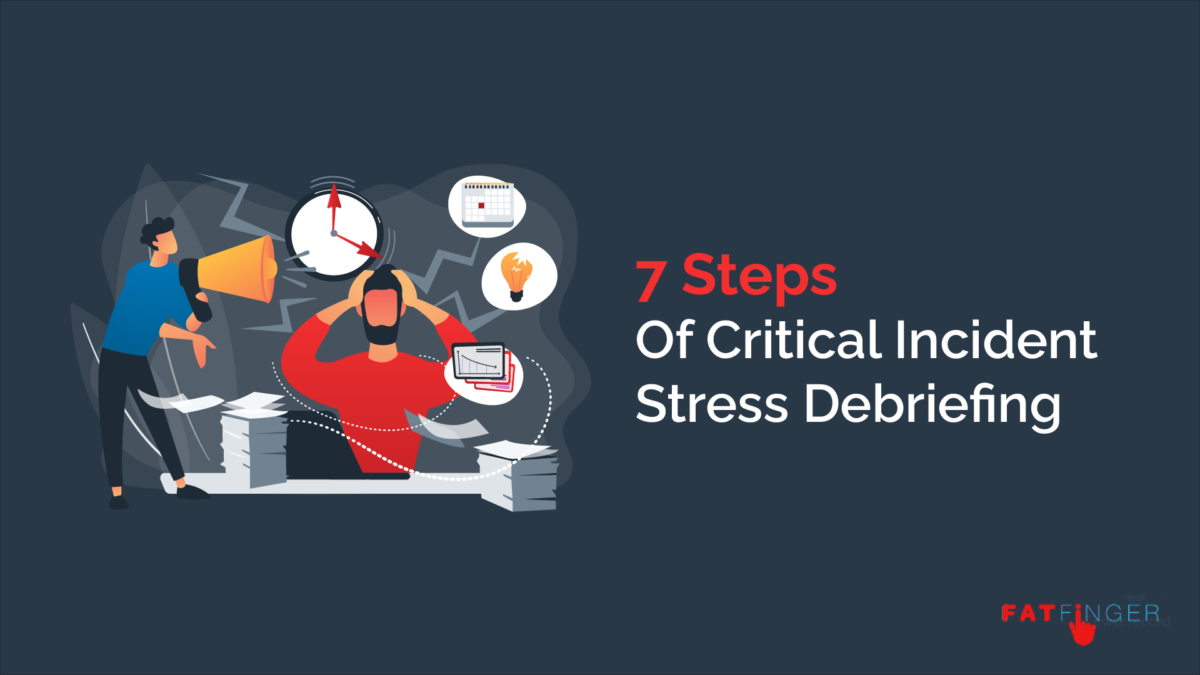What is Critical Incident Stress Debriefing?
How does critical incident stress debriefing work?
In practice, a critical stress debriefing has three main goals:
What defines a “critical incident”?

7 Step Critical Incident Stress Debriefing Process

Phase 1 – Identify the problem / assess the impact
The first step in the critical incident stress debriefing process is to get the basic information down about the individual. This will include:
- Name and email addresses of yourself, the person you report to, and the individual you are assisting
Then, you’ll need to define the nature of the incident you are helping the individual with. If you’re running a group session, each person might introduce themselves at this stage and talk about why they’re present.
Once you clearly understand the critical incidents at hand, you’ll begin to make an assessment.
Phase 2: Identify immediate issues regarding safety and security
During the second phase, you’ll ask questions and prompts to try and understand the individual’s sense of safety and security. For many trauma survivors, this is something that can diminish extremely quickly after the event.
Phase 3: Defusing/venting
The third stage begins by asking individuals questions about what they think about the critical stress incident. You might ask something like “so what happened next?”, “what were you thinking at that time?” or “what did you feel once X happened?”
If this is a group exercise, people will take it in turns to share. The discussion can go from talking about thoughts, feelings, or emotions – the primary focus of this phase is to establish a space that’s safe and supportive that invites individuals to share comfortably.
Phase 4: Predict future events and reactions
Don’t worry, you won’t need a crystal ball for this. All you need to do in this fourth phase is open up a discussion about the impact of the critical stress incident.
This stage is more focused on feelings rather than thoughts. And it’s where individuals can open up about their experience’s emotional impact.
They might express feelings of loss, sadness, anger, confusion, etc. Your job is to ask them questions to help them identify their feelings.
To do so, you might ask a question such as: “what was the hardest part of this for you?” or “what feelings were you expecting, and is that what you really experienced?”
Phase 5: Symptoms
Here’s where you can help individuals better understand the symptoms they’re experiencing as a direct result of the critical stress incident.
You could share a comprehensive list of common post-stress symptoms. Find a balance between physical and psychological symptoms, and help them to identify which ones they’re experiencing.
This phase is important for the individual’s recovery journey as you can help to normalize their feelings.
It also helps to reassure them that their natural response are expected after experiencing a traumatic ordeal.
Phase 6 – Teaching
In this teaching phase, the person conducting the debriefing should attempt to normalize what individuals spoke about in the previous phase. This is a good time to provide stress management information that individuals can use once the debriefing is over.
Now is also the time to address any additional topics that the individual might find beneficial to explore.
For example, if the individual’s critical stress incident was a drug overdose in the family, you should speak about addictions and substance abuse.
Phase 7 – Re-entry
In the final phase, you’ll help individuals develop a coping plan to move forward. The goal is to empower individuals to better handle their feelings after a stressful incident—you can summarize things that were said or give the floor to individuals to ask their own questions or share any final thoughts or feelings.
End phase: follow up
The follow-up phase is vital, and it’s typically the last contact you’ll have with the individual on this topic.
The CISD framework recommends that you follow up with the individual a few days after the final conversation, but before a whole week has passed.
Here’s where you can find out how they’re doing or whether they’ve been implementing any of the critical stress incident management help they received. During this conversation, you should determine if they might benefit from additional support—counseling or other medical services like therapy have been proven to help with post-traumatic stress.
Is critical incident stress therapy enough to overcome PTSD?

Short answer? No.
Critical incident stress therapy does not exist to replace traditional treatment, and it has never intended to. CISD can help individuals identify their feelings and take the first step in seeking help. But traditional therapy is what can help survivors deal with long-term symptoms.
In fact, it’s common for leaders and CISD providers to refer individuals to therapy and various types of professional care after they’ve made an assessment.
Here are some signs that the individuals you are delivering CISD to may benefit from therapy:
- Continuing sleep difficulties
- Intense and/or chronic anxiety
- The presence of depression symptoms
- New or intensified substance use
- Prolonged fear
- A sense of having no control over one or more aspects of life
- Simultaneous life stressors in addition to the effects of trauma
- Previously existing mental health challenges
- Lack of social support
How effective is critical incident stress debriefing?
According to the Journal of Emergency Nursing, critical incident stress debriefing was developed “as a therapeutic technique with first responders after they’ve been exposed to an excessively or horrific critical incident”.
But although CISD has a long track record of facilitating coping mechanisms among trauma survivors, some researchers challenge its effectiveness. and the research shows mixed results.
Here’s an example: some critics of CISD argue that talking bout traumatic events so soon after the event may actually increase the chance of post-traumatic stress disorder.
Another common concern is that leaders might mistakenly give it to people who don’t actually need it.
This could be people who are either not distressed about the incident, or too distressed to be able to share their feelings in a group setting.
But there are several studies that demonstrate that critical stress debriefing is in fact effective.
For example, in a 1995 study of emergency medical responders, CISD providers gave 36 workers critical stress incident debriefing within 24 hours of the traumatic event (a mass shooting that resulted in several deaths and fatalities). Half of those workers reported feeling fewer symptoms of post-traumatic stress, depression, and anxiety.
In a separate study of hurricane victims in 1997, two groups were surveyed. The first group received CISD and they reported less distress than the second group that didn’t.
At the very least, critical incident stress debriefing can help trauma survivors to normalize the feelings, fears, anxiety, or depression they might feel as a response to the event.
How to deliver critical incident stress debriefing with FAT FINGER
Life doesn’t always go to plan. So when it doesn’t, it’s vital that you’re 100% prepared to support your employees’ mental health.
That’s where FAT FINGER’S responsive checklist builder comes in.
You can ensure your team has everything they need to overcome traumatic incidents and stay on track with each debriefing phase.
Each phase of the debriefing process contains several sub-phases and there’s quite a lot of ground to cover. By creating your checklist on FAT FINGER, you can make sure you tick off each phase at the right time, answer each question ( in the right order), and complete any follow-up tasks in a timely fashion.
It’s completely customizable and you can automatically assign tasks to others, making the debriefing process as seamless as possible. Sign up for a free demo of the platform here and see just how easy it is.


